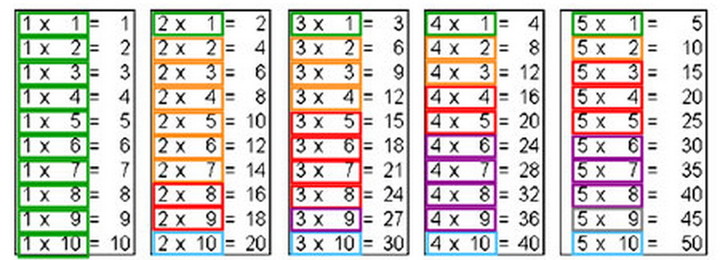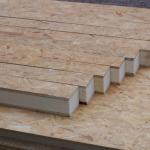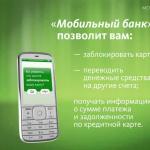How to teach a child the multiplication table?
The multiplication table, without exaggeration, is one of the foundations of mathematical science. Without her knowledge, teaching mathematics and algebra will become very difficult, if not impossible at all.
And in everyday life, the multiplication table is in demand almost daily. That is why so much time is devoted to its development in elementary school.
However, the study of the Pythagorean table cannot be called easy: the multiplication skill is mastered with difficulty, and it is also not easy for a child to memorize all this considerable mass of numbers.
The task of parents is to help children in learning the multiplication table, making the process interesting and at the same time productive.
Easy Ways to Teach Kids the Multiplication Table
The good old counting material, as well as various “tips” in the form of poems, songs and interesting memorable pictures, have not been canceled either.
Having an idea about the basic teaching methods: memorization, game, visualization - parents are able to independently teach the child the multiplication table.
![]()
memorization
The task of "learning a table" involves, among other things, its literal memorization. It has been noticed that it is much easier to memorize material in a poetic form or in the form of a song, especially when it comes to children.
If you arrange and rhyme the multiplication examples, then all the necessary numbers will really get fixed in memory much faster.
You can use any verses (for example, you can learn with your child the words of the song by V. Shainsky and M. Plyatskovsky “Twice two - four”). And parents with fantasy can connect it and come up with their own rhymes, it's easy, for example: "six seven - forty-two, an owl flew to us."
 In extreme cases, if the table is no longer remembered in any way, there remains a routine, but proven by more than one generation of schoolchildren, method - to memorize it. However, keep in mind that this method is not at all like the kids.
In extreme cases, if the table is no longer remembered in any way, there remains a routine, but proven by more than one generation of schoolchildren, method - to memorize it. However, keep in mind that this method is not at all like the kids.
It should be remembered that memorization cannot be the only method of teaching a child the multiplication table. It is important not only to remember the sequence of numbers, but also to understand the essence of the action itself. This is what will help a child at an older age solve complex multiplication examples.
Visualization
Another way to master the Pythagorean table is its visualization, which involves the use of all kinds of visual materials.
It can be:
- counting materials;
- Pictures;
- and even fingers!
With the help of counting material, whether it be sticks, geometric figures or something else, you can show the child the essence of multiplication (“6 x 5” means “take 6 times 5 objects”).
 In addition, the kid can count the figures presented and make sure that the answer is exactly the same as in the Pythagorean table.
In addition, the kid can count the figures presented and make sure that the answer is exactly the same as in the Pythagorean table.
With the help of pictures
If a child likes to draw, this is a great opportunity to study the table with the help of pictures.
The principle of operation is approximately the same as in the case of counting material, only instead of laying out 6 times 5 sticks in front of a young mathematician, you can draw directly opposite the example of 6 squares / cakes / wagons with 5 dots / cherries / bunnies inside each.
True, it will be difficult to draw whole pictures when multiplying large numbers.
On fingers
A good option would be to study part of the Pythagorean table, namely the column with a nine, on the fingers. Such a kind of life hack will interest any child.
Place your hands in front of you with your palms out and mentally number them from 1 to 10, starting with the left little finger. Tabular examples for multiplication with the number 9 are solved very simply: just bend your finger, the number of which matches the second factor.
So, multiplying 3 by 9, we bend the middle finger on the left hand. The fingers that are located before the bent one (there are two of them) indicate the number of tens, and the rest (there are seven) - the number of units.
In total, we get 27 in the answer. Fast, easy and interesting!
Through educational cartoons and programs
Of course, educational cartoons, applications on mobile devices and programs on a PC can be used as visualization tools, if there is such an opportunity and parents are not against such a pastime for the child.
Of course, to study such a recalcitrant multiplication table, all means are good, but remember that everything should be in moderation, and do not leave the baby in the care of the gadget in this difficult matter, but rather join it yourself.
A game
Learning in a playful way always attracts kids. Learning the multiplication table is good on the material of the card game. Cards are made of cardboard for each example of a table, a numerical expression is written on one side (5 x 3 \u003d?), And on the other - the answer.
 Players take turns drawing cards, solving an example and checking themselves by looking at the back side. If the answer is correct, the card remains with the player, if not, it is returned to the deck. The winner is the one with the most cards at the end of the game.
Players take turns drawing cards, solving an example and checking themselves by looking at the back side. If the answer is correct, the card remains with the player, if not, it is returned to the deck. The winner is the one with the most cards at the end of the game.
First steps in learning the table: the easiest numbers and mastering the principle
Some examples from the Pythagorean table are burned into memory almost instantly, while others, no matter how hard they work, do not want to obey. It is logical that you need to start mastering the table with more accommodating numbers.
So, it will not be difficult for a child to remember a column of examples with a one, since the answers will be identical to the changing factor. Next, you can begin to study the column with the number 2, because such a multiplication is easy to illustrate by any means at hand, adding two each time.

After that, the column with four will be well remembered, because in order to multiply by 4, you need to multiply by 2 and another by 2. Experienced parents noticed that children easily master multiplication by 5, since the answers in this column end only in 0 and 5.

Well, with multiplication from 6 to 9 (plus the number 3) you can figure it out a little later, especially since some of them (namely, multiplying these numbers by 1, 2, 4 and 5) will already be mastered. And if you decide to use the multiplication method described above on the fingers, then there will be no problems with the nine.

When the approximate scope of work is outlined, it remains to determine how to explain the essence of multiplication to the baby, so that he understands. To begin with, it is worth telling the child that this mathematical action was invented to speed up and facilitate the calculation.

It would be nice to come up with a bright situation to illustrate this statement. For example: “You have 10 bags and each contains 8 sweets. It will take a few minutes to count the sweets in order. And if you know a tricky way - multiplication - you will spend only a couple of seconds. Usually such motivation is to the liking of children.

The essence of multiplication is simple, it can be explained both visually and with the help of numbers. In the first case, using counting material, explain to the child that multiplication is “taking so many times so many times.”
If it seems to you that the child is more likely to understand the digital notation, tell them that the expression "5 x 6" is a shorthand for the expression "5 + 5 + 5 + 5 + 5 + 5". Thus, multiplication not only facilitates counting, but also makes it possible to briefly write down the sum of identical terms.
 And this means that homework in mathematics will take much less time - what is not a great reason to memorize the table?
And this means that homework in mathematics will take much less time - what is not a great reason to memorize the table?
How to fix the result?
The best way to master a skill is to put it into practice. In order for the development of the Pythagorean table to be successful, do not forget to put the new knowledge of the baby into action.
On a walk, ask them to tell you how many wheels four cars have, how many legs five cats have. At dinner, find out how many plates to put on the table if each of the three diners needs two pieces. From time to time repeat the cases of tabular multiplication in verses.
Many parents advise to memorize the multiplication tables and, outside school hours, simply hang Pythagorean tables in different places at home so that the child can repeat the material at any time.
 A good way to consolidate knowledge is the game. Use the cards mentioned above for her. Play with the whole family, let adults sometimes make mistakes on purpose so that the child can correct them, demonstrating their knowledge.
A good way to consolidate knowledge is the game. Use the cards mentioned above for her. Play with the whole family, let adults sometimes make mistakes on purpose so that the child can correct them, demonstrating their knowledge.
How to help your child learn and remember information faster?
Mastering the multiplication table is not a very fast process. However, at school, the number of hours for any material is limited, and, of course, the teacher in the next lesson (and mathematics lessons in elementary school are usually daily) will already demand a certain result.
Therefore, parents need in every possible way to help the child understand and remember the information received.
When studying the Pythagorean table with the baby, pay attention to the fact that many examples are repeated in it, only the numbers in the first part of the numerical expressions are reversed: 3 x 7 = 21 and 7 x 3 = 21.
 Having understood this, the child will quickly realize that he will not have to learn about half of the table at all, and in fact, the number of examples that need to be remembered is much less than it seems at first glance! For clarity, repeating examples can be highlighted in the table with the same color.
Having understood this, the child will quickly realize that he will not have to learn about half of the table at all, and in fact, the number of examples that need to be remembered is much less than it seems at first glance! For clarity, repeating examples can be highlighted in the table with the same color.
 You can draw the child's attention to some interesting facts discovered during a detailed study of the Pythagorean table and related to the reduction of numbers (that is, following the method of Pythagoras himself, by adding the numbers that make up the two-digit numbers of the table).
You can draw the child's attention to some interesting facts discovered during a detailed study of the Pythagorean table and related to the reduction of numbers (that is, following the method of Pythagoras himself, by adding the numbers that make up the two-digit numbers of the table).
So, in the column with nine, the sum of the digits of each two-digit number in the answer will be 9. If you reduce the numbers in the column with the number eight in this way, you get a sequence from 8 to 1 in order. In a column with a six, the sequence 6, 3, 9 will be repeated three times, and in a column with a triple - 3, 6, 9.
You can show the little conqueror of big mathematics the following trick: if you take the first answer in the column with nine as 09 (and not just 9), then the numbers in the answers will line up in two columns, and the left one will be a series of numbers arranged in order from 0 to 9 , and the right one is from 9 to 0.

It will be nice if you can provide the baby with a multiplication table in the form of a square, along the edges of which numbers from 1 to 9 are written, and inside the results of their multiplication are recorded. By drawing lines from the factors above and to the left, at their intersection you can see the desired number.
It is important to explain to the child that the result of a numerical expression can be found in any way: you can remember the result, or you can count on your fingers or apply the knowledge of “tricks”, in extreme cases it is even possible to quickly perform addition.
Or, for example, if you forgot how much it will be 9 x 3, then how much will it be 3 x 9, you will surely be able to remember? The ability to use different methods to solve a problem will be useful to the baby in life.

How to teach a child to deal with complex examples?
Before proceeding to complex examples, you need to make sure that the child knows the source material by heart - the Pythagorean table. If you managed to cope with this, you can start multiplying the form of a two-digit number by a one-digit number.
Explain to the child what is necessary in this case:
- Write the numbers in a column, two-digit - on top.
- Multiply by a single number, first two-digit units, then tens (further, you can increase the capacity of the first multiplier, mentioning that each larger digit is multiplied after the smaller one);
- If, when multiplying one digit by a single-digit number, a two-digit number is obtained, then a number indicating the number of units of the resulting number is written under the bar, and the number indicating the number of tens is written over the next digit of the first multiplier and added to the number obtained by multiplying this digit by a single-digit.

It sounds complicated, but the example is much simpler. After some time, not without the help of the school curriculum, the kid will master this action, and will be able to move on to more complex calculations. Remember that it is not worth it to specifically ask the child too difficult tasks - everything has its time.
Interest, motivation, play - this is what is at the forefront in education today, especially when it comes to young children. It has been proven that if a child is passionate about the material, he learns it much faster and better.
Cramming is a good option, but its result is often short-lived: after writing an important test or passing an exam, we are happy to forget what we repeated day and night a couple of days ago. That is why it is important to make the study of complex material, such as the Pythagorean table, interesting for children.
There are different ways to do this:
- motivation - an explanation of where the superpower to multiply numbers comes in handy for a child and how much better it is to quickly multiply them than to add them slowly;
- stimulation, in other words, the promise of something pleasant when a result is achieved (but remember that this method cannot be abused, otherwise one fine day you simply will not materially pull another “pretty girl”);
- praise: for every even the smallest step forward, the child needs to be praised, and significant advances should be well encouraged with an exciting walk, playing together or going to the cinema or museum, and at the same time you can repeat a couple of examples;
- learning in a playful way: use not mathematical dictations or tests to test the child's knowledge - they are enough for him at school - but games (the same card or computer games). Or arrange a family-wide educational quiz or even a hidden object quest with the help of hints, which can only be obtained by correctly solving the example.
Do not forget that it is impossible to load the baby with an excessive amount of material in one lesson, in the end the child will get bored and will not learn even half, and if he learns, he will have time to forget. Let your home lessons not be too long, then the multiplication will not have time to bother the student.
It is important to take breaks during classes so that the baby can warm up and change the type of activity. And in order not to shy away from the topic, you can hold a mathematical physical minute: the parent throws the ball to the child with a question, for example, “Five five -?”, He catches and throws it back, voicing the answer.
What mistakes are important to avoid when working with a child?
Memorizing the multiplication table is not an easy task. The efforts of children do not always bring results immediately, and the patience of parents and grandparents is not unlimited. However, by applying the ability to think in time, we can protect ourselves and the child from our own rash words and actions.
So, in no case should you:
- rush the child if, in your opinion, he solves the example for too long (if, of course, he really solves it, and is not distracted by drawing or something else);
- to scold the baby, and even more so to give him impartial assessments and nicknames - this will not add motivation to him, but a reluctance to engage in it may arise;
- expect a quick assimilation of a large amount of material and be upset when this does not happen (and this will not happen);
- compare the success of the child with the success of his friends, classmates and brothers (in any case, one of the children will have to be elevated in front of the other, which is unlikely to make the relationship between them better).
 Every parent can help a child learn the multiplication table. It is enough to show a little patience, imagination and interest - then the work will go like clockwork. Studying with interest, and not boring boring material from a stick, children will more readily and quickly master multiplication.
Every parent can help a child learn the multiplication table. It is enough to show a little patience, imagination and interest - then the work will go like clockwork. Studying with interest, and not boring boring material from a stick, children will more readily and quickly master multiplication.




